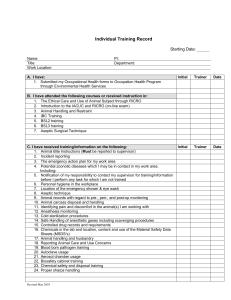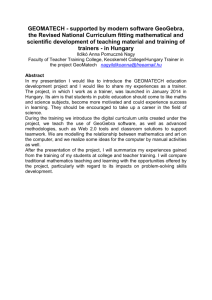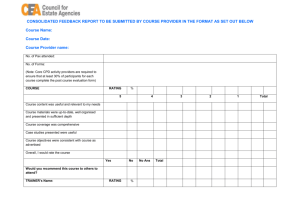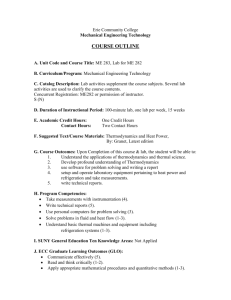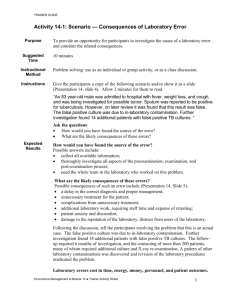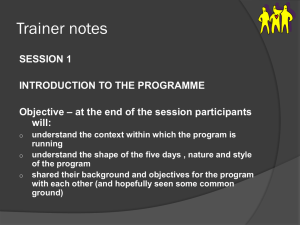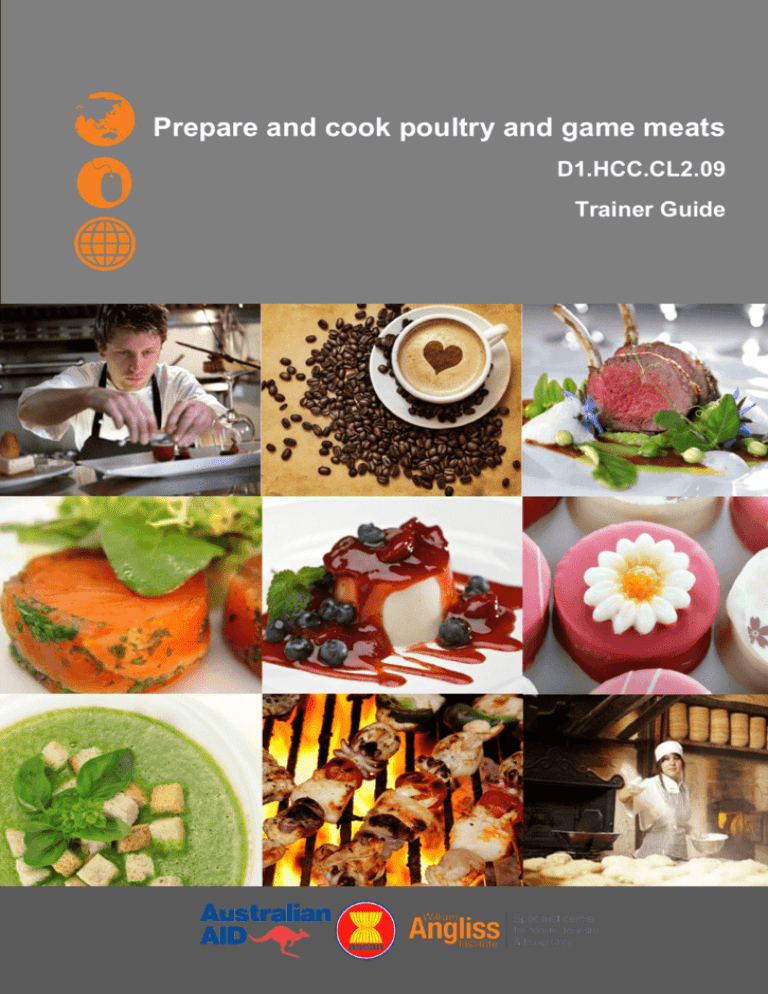
Prepare and cook poultry and game meats
D1.HCC.CL2.09
Trainer Guide
Prepare and cook poultry
and game meats
D1.HCC.CL2.09
Trainer Guide
© ASEAN 2012
Trainer Guide
Prepare and cook poultry and game meats
Project Base
William Angliss Institute of TAFE
555 La Trobe Street
Melbourne 3000 Victoria
Telephone:
(03) 9606 2111
Facsimile:
(03) 9670 1330
Acknowledgements
Project Director:
Chief Writer:
Subject Writer:
Project Manager:
Editor:
DTP/Production:
Wayne Crosbie
Alan Hickman
Garry Blackburn
Alan Maguire
Jim Irwin
Daniel Chee, Mai Vu, Jirayu Thangcharoensamut
The Association of Southeast Asian Nations (ASEAN) was established on 8 August 1967. The Member
States of the Association are Brunei Darussalam, Cambodia, Indonesia, Lao PDR, Malaysia,
Myanmar, Philippines, Singapore, Thailand and Viet Nam.
The ASEAN Secretariat is based in Jakarta, Indonesia.
General Information on ASEAN appears online at the ASEAN Website: www.asean.org.
All text is produced by William Angliss Institute of TAFE for the ASEAN Project on “Toolbox
Development for Front Office, Food and Beverage Services and Food Production Divisions”.
This publication is supported by Australian Aid through the ASEAN-Australia Development
Cooperation Program Phase II (AADCP II)
Copyright: Association of Southeast Asian Nations (ASEAN) 2012
All rights reserved.
Disclaimer
Every effort has been made to ensure that this publication is free from errors or omissions. However,
you should conduct your own enquiries and seek professional advice before relying on any fact,
statement or matter contained in this book. ASEAN Secretariat and William Angliss Institute of TAFE
are not responsible for any injury, loss or damage as a result of material included or omitted from this
course. Information in this module is current at the time of publication. Time of publication is indicated
in the date stamp at the bottom of each page.
Some images appearing in this resource have been purchased from various stock photography
suppliers and other third party copyright owners and as such are non-transferable and non-exclusive.
Additional images have been sourced from Flickr and are used under:
http://creativecommons.org/licenses/by/2.0/deed.en
http://www.sxc.hu/
File name: TG_Prepare_&_cook_poultry_&_game_meats_240812
© ASEAN 2012
Trainer Guide
Prepare and cook poultry and game meats
Table of contents
Competency Based Training (CBT) and assessment - An introduction for trainers ........... 1
Competency standard ..................................................................................................... 11
Notes and PowerPoint slides .......................................................................................... 21
Cookery practical classes: Recommended training equipment ....................................... 51
Instructions for Trainers for using PowerPoint – Presenter View ..................................... 53
Appendix – ASEAN acronyms ........................................................................................ 55
© ASEAN 2012
Trainer Guide
Prepare and cook poultry and game meats
© ASEAN 2012
Trainer Guide
Prepare and cook poultry and game meats
Competency Based Training (CBT) and assessment - An introduction for trainers
Competency Based Training (CBT) and
assessment - An introduction for trainers
Competency
Competency refers to the ability to perform particular tasks and duties to the standard of
performance expected in the workplace.
Competency requires the application of specified knowledge, skills and attitudes relevant
to effective participation, consistently over time and in the workplace environment.
The essential skills and knowledge are either identified separately or combined.
Knowledge identifies what a person needs to know to perform the work in an informed
and effective manner.
Skills describe the application of knowledge to situations where understanding is
converted into a workplace outcome.
Attitude describes the founding reasons behind the need for certain knowledge or why
skills are performed in a specified manner.
Competency covers all aspects of workplace performance and involves:
Performing individual tasks
Managing a range of different tasks
Responding to contingencies or breakdowns
Dealing with the responsibilities of the workplace
Working with others.
Unit of Competency
Like with any training qualification or program, a range of subject topics are identified that
focus on the ability in a certain work area, responsibility or function.
Each manual focuses on a specific unit of competency that applies in the hospitality
workplace.
In this manual a unit of competency is identified as a „unit‟.
Each unit of competency identifies a discrete workplace requirement and includes:
Knowledge and skills that underpin competency
Language, literacy and numeracy
Occupational health and safety requirements.
Each unit of competency must be adhered to in training and assessment to ensure
consistency of outcomes.
© ASEAN 2012
Trainer Guide
Prepare and cook poultry and game meats
1
Competency Based Training (CBT) and assessment - An introduction for trainers
Element of Competency
An element of competency describes the essential outcomes within a unit of competency.
The elements of competency are the basic building blocks of the unit of competency.
They describe in terms of outcomes the significant functions and tasks that make up the
competency.
In this manual elements of competency are identified as an „element‟.
Performance criteria
Performance criteria indicate the standard of performance that is required to demonstrate
achievement within an element of competency. The standards reflect identified industry
skill needs.
Performance criteria will be made up of certain specified skills, knowledge and attitudes.
Learning
For the purpose of this manual learning incorporates two key activities:
Training
Assessment.
Both of these activities will be discussed in detail in this introduction.
Today training and assessment can be delivered in a variety of ways. It may be provided
to participants:
On-the-job – in the workplace
Off-the-job – at an educational institution or dedicated training environment
As a combination of these two options.
No longer is it necessary for learners to be absent from the workplace for long periods of
time in order to obtain recognised and accredited qualifications.
Learning Approaches
This manual will identify two avenues to facilitate learning:
Competency Based Training (CBT)
This is the strategy of developing a participant‟s competency.
Educational institutions utilise a range of training strategies to ensure that participants are
able to gain the knowledge and skills required for successful:
Completion of the training program or qualification
Implementation in the workplace.
The strategies selected should be chosen based on suitability and the learning styles of
participants.
2
© ASEAN 2012
Trainer Guide
Prepare and cook poultry and game meats
Competency Based Training (CBT) and assessment - An introduction for trainers
Competency Based Assessment (CBA)
This is the strategy of assessing competency of a participant.
Educational institutions utilise a range of assessment strategies to ensure that
participants are assessed in a manner that demonstrates validity, fairness, reliability,
flexibility and fairness of assessment processes.
Flexibility in Learning
It is important to note that flexibility in training and assessment strategies is required to
meet the needs of participants who may have learning difficulties. The strategies used will
vary, taking into account the needs of individual participants with learning difficulties.
However they will be applied in a manner which does not discriminate against the
participant or the participant body as a whole.
Catering for Participant Diversity
Participants have diverse backgrounds, needs and interests. When planning training and
assessment activities to cater for individual differences, trainers and assessors should:
Consider individuals‟ experiences, learning styles and interests
Develop questions and activities that are aimed at different levels of ability
Modify the expectations for some participants
Provide opportunities for a variety of forms of participation, such as individual, pair and
small group activities
Assess participants based on individual progress and outcomes.
The diversity among participants also provides a good reason for building up a learning
community in which participants support each other‟s learning.
Participant Centred Learning
This involves taking into account structuring training and assessment that:
Builds on strengths – Training environments need to demonstrate the many positive
features of local participants (such as the attribution of academic success to effort,
and the social nature of achievement motivation) and of their trainers (such as a
strong emphasis on subject disciplines and moral responsibility). These strengths and
uniqueness of local participants and trainers should be acknowledged and treasured
Acknowledges prior knowledge and experience – The learning activities should be
planned with participants‟ prior knowledge and experience in mind
Understands learning objectives – Each learning activity should have clear learning
objectives and participants should be informed of them at the outset. Trainers should
also be clear about the purpose of assignments and explain their significance to
participants
Teaches for understanding – The pedagogies chosen should aim at enabling
participants to act and think flexibly with what they know
Teaches for independent learning – Generic skills and reflection should be nurtured
through learning activities in appropriate contexts of the curriculum. Participants
should be encouraged to take responsibility for their own learning
Enhances motivation – Learning is most effective when participants are motivated.
Various strategies should be used to arouse the interest of participants
© ASEAN 2012
Trainer Guide
Prepare and cook poultry and game meats
3
Competency Based Training (CBT) and assessment - An introduction for trainers
Makes effective use of resources – A variety of teaching resources can be employed
as tools for learning
Maximises engagement – In conducting learning activities, it is important for the minds
of participants to be actively engaged
Aligns assessment with learning and teaching – Feedback and assessment should be
an integral part of learning and teaching
Caters for learner diversity – Trainers should be aware that participants have different
characteristics and strengths and try to nurture these rather than impose a standard
set of expectations.
Active Learning
The goal of nurturing independent learning in participants does not imply that they always
have to work in isolation or solely in a classroom. On the contrary, the construction of
knowledge in tourism and hospitality studies can often best be carried out in collaboration
with others in the field. Sharing experiences, insights and views on issues of common
concern, and working together to collect information through conducting investigative
studies in the field (active learning) can contribute a lot to their eventual success.
Active learning has an important part to play in fostering a sense of community in the
class. First, to operate successfully, a learning community requires an ethos of
acceptance and a sense of trust among participants, and between them and their trainers.
Trainers can help to foster acceptance and trust through encouragement and personal
example, and by allowing participants to take risks as they explore and articulate their
views, however immature these may appear to be. Participants also come to realise that
their classmates (and their trainers) are partners in learning and solving.
Trainers can also encourage cooperative learning by designing appropriate group
learning tasks, which include, for example, collecting background information, conducting
small-scale surveys, or producing media presentations on certain issues and themes.
Participants need to be reminded that, while they should work towards successful
completion of the field tasks, developing positive peer relationships in the process is an
important objective of all group work.
Competency Based Training (CBT)
Principle of Competency Based Training
Competency based training is aimed at developing the knowledge, skills and attitudes of
participants, through a variety of training tools.
Training Strategies
The aims of this curriculum are to enable participants to:
Undertake a variety of subject courses that are relevant to industry in the current
environment
Learn current industry skills, information and trends relevant to industry
Learn through a range of practical and theoretical approaches
Be able to identify, explore and solve issues in a productive manner
4
© ASEAN 2012
Trainer Guide
Prepare and cook poultry and game meats
Competency Based Training (CBT) and assessment - An introduction for trainers
Be able to become confident, equipped and flexible managers of the future
Be „job ready‟ and a valuable employee in the industry upon graduation of any
qualification level.
To ensure participants are able to gain the knowledge and skills required to meet
competency in each unit of competency in the qualification, a range of training delivery
modes are used.
Types of Training
In choosing learning and teaching strategies, trainers should take into account the
practical, complex and multi-disciplinary nature of the subject area, as well as their
participant‟s prior knowledge, learning styles and abilities.
Training outcomes can be attained by utilising one or more delivery methods:
Lecture/Tutorial
This is a common method of training involving transfer of information from the trainer to
the participants. It is an effective approach to introduce new concepts or information to the
learners and also to build upon the existing knowledge. The listener is expected to reflect
on the subject and seek clarifications on the doubts.
Demonstration
Demonstration is a very effective training method that involves a trainer showing a
participant how to perform a task or activity. Through a visual demonstration, trainers may
also explain reasoning behind certain actions or provide supplementary information to
help facilitate understanding.
Group Discussions
Brainstorming in which all the members in a group express their ideas, views and
opinions on a given topic. It is a free flow and exchange of knowledge among the
participants and the trainer. The discussion is carried out by the group on the basis of
their own experience, perceptions and values. This will facilitate acquiring new
knowledge. When everybody is expected to participate in the group discussion, even the
introverted persons will also get stimulated and try to articulate their feelings.
The ideas that emerge in the discussions should be noted down and presentations are to
be made by the groups. Sometimes consensus needs to be arrived at on a given topic.
Group discussions are to be held under the moderation of a leader guided by the trainer.
Group discussion technique triggers thinking process, encourages interactions and
enhances communication skills.
Role Play
This is a common and very effective method of bringing into the classroom real life
situations, which may not otherwise be possible. Participants are made to enact a
particular role so as to give a real feel of the roles they may be called upon to play. This
enables participants to understand the behaviour of others as well as their own emotions
and feelings. The instructor must brief the role players on what is expected of them. The
role player may either be given a ready-made script, which they can memorize and enact,
or they may be required to develop their own scripts around a given situation. This
technique is extremely useful in understanding creative selling techniques and human
relations. It can be entertaining and energizing and it helps the reserved and less literate
to express their feelings.
© ASEAN 2012
Trainer Guide
Prepare and cook poultry and game meats
5
Competency Based Training (CBT) and assessment - An introduction for trainers
Simulation Games
When trainees need to become aware of something that they have not been conscious of,
simulations can be a useful mechanism. Simulation games are a method based on "here
and now" experience shared by all the participants. The games focus on the participation
of the trainees and their willingness to share their ideas with others. A "near real life"
situation is created providing an opportunity to which they apply themselves by adopting
certain behaviour. They then experience the impact of their behaviour on the situation. It
is carried out to generate responses and reactions based on the real feelings of the
participants, which are subsequently analysed by the trainer.
While use of simulation games can result in very effective learning, it needs considerable
trainer competence to analyse the situations.
Individual /Group Exercises
Exercises are often introduced to find out how much the participant has assimilated. This
method involves imparting instructions to participants on a particular subject through use
of written exercises. In the group exercises, the entire class is divided into small groups,
and members are asked to collaborate to arrive at a consensus or solution to a problem.
Case Study
This is a training method that enables the trainer and the participant to experience a real
life situation. It may be on account of events in the past or situations in the present, in
which there may be one or more problems to be solved and decisions to be taken. The
basic objective of a case study is to help participants diagnose, analyse and/or solve a
particular problem and to make them internalize the critical inputs delivered in the training.
Questions are generally given at the end of the case study to direct the participants and to
stimulate their thinking towards possible solutions. Studies may be presented in written or
verbal form.
Field Visit
This involves a carefully planned visit or tour to a place of learning or interest. The idea is
to give first-hand knowledge by personal observation of field situations, and to relate
theory with practice. The emphasis is on observing, exploring, asking questions and
understanding. The trainer should remember to brief the participants about what they
should observe and about the customs and norms that need to be respected.
Group Presentation
The participants are asked to work in groups and produce the results and findings of their
group work to the members of another sub-group. By this method participants get a good
picture of each other's views and perceptions on the topic and they are able to compare
them with their own point of view. The pooling and sharing of findings enriches the
discussion and learning process.
Practice Sessions
This method is of paramount importance for skills training. Participants are provided with
an opportunity to practice in a controlled situation what they have learnt. It could be real
life or through a make-believe situation.
6
© ASEAN 2012
Trainer Guide
Prepare and cook poultry and game meats
Competency Based Training (CBT) and assessment - An introduction for trainers
Games
This is a group process and includes those methods that involve usually fun-based
activity, aimed at conveying feelings and experiences, which are everyday in nature, and
applying them within the game being played. A game has set rules and regulations, and
may or may not include a competitive element. After the game is played, it is essential
that the participants be debriefed and their lessons and experiences consolidated by the
trainer.
Research
Trainers may require learners to undertake research activities, including online research,
to gather information or further understanding about a specific subject area.
Competency Based Assessment (CBA)
Principle of Competency Based Assessment
Competency based assessment is aimed at compiling a list of evidence that shows that a
person is competent in a particular unit of competency.
Competencies are gained through a multitude of ways including:
Training and development programs
Formal education
Life experience
Apprenticeships
On-the-job experience
Self-help programs.
All of these together contribute to job competence in a person. Ultimately, assessors and
participants work together, through the „collection of evidence‟ in determining overall
competence.
This evidence can be collected:
Using different formats
Using different people
Collected over a period of time.
The assessor who is ideally someone with considerable experience in the area being
assessed, reviews the evidence and verifies the person as being competent or not.
Flexibility in Assessment
Whilst allocated assessment tools have been identified for this subject, all attempts are
made to determine competency and suitable alternate assessment tools may be used,
according to the requirements of the participant.
The assessment needs to be equitable for all participants, taking into account their
cultural and linguistic needs.
© ASEAN 2012
Trainer Guide
Prepare and cook poultry and game meats
7
Competency Based Training (CBT) and assessment - An introduction for trainers
Competency must be proven regardless of:
Language
Delivery Method
Assessment Method.
Assessment Objectives
The assessment tools used for subjects are designed to determine competency against
the „elements of competency‟ and their associated „performance criteria‟.
The assessment tools are used to identify sufficient:
a) Knowledge, including underpinning knowledge
b) Skills
c) Attitudes
Assessment tools are activities that trainees are required to undertake to prove participant
competency in this subject.
All assessments must be completed satisfactorily for participants to obtain competence in
this subject. There are no exceptions to this requirement, however, it is possible that in
some cases several assessment items may be combined and assessed together.
Types of Assessment
Allocated Assessment Tools
There are a number of assessment tools that are used to determine competency in this
subject:
Work projects
Written questions
Oral questions
Third Party Report
Observation Checklist.
Instructions on how assessors should conduct these assessment methods are explained
in the Assessment Manuals.
Alternative Assessment Tools
Whilst this subject has identified assessment tools, as indicated above, this does not
restrict the assessor from using different assessment methods to measure the
competency of a participant.
Evidence is simply proof that the assessor gathers to show participants can actually do
what they are required to do.
Whilst there is a distinct requirement for participants to demonstrate competency, there
are many and diverse sources of evidence available to the assessor.
Ongoing performance at work, as verified by a supervisor or physical evidence, can count
towards assessment. Additionally, the assessor can talk to customers or work colleagues
to gather evidence about performance.
8
© ASEAN 2012
Trainer Guide
Prepare and cook poultry and game meats
Competency Based Training (CBT) and assessment - An introduction for trainers
A range of assessment methods to assess competency include:
Practical demonstrations
Practical demonstrations in simulated work conditions
Problem solving
Portfolios of evidence
Critical incident reports
Journals
Oral presentations
Interviews
Videos
Visuals: slides, audio tapes
Case studies
Log books
Projects
Role plays
Group projects
Group discussions
Examinations.
Recognition of Prior Learning
Recognition of Prior Learning is the process that gives current industry professionals who
do not have a formal qualification, the opportunity to benchmark their extensive skills and
experience against the standards set out in each unit of competency/subject.
Also known as a Skills Recognition Audit (SRA), this process is a learning and
assessment pathway which encompasses:
Recognition of Current Competencies (RCC)
Skills auditing
Gap analysis and training
Credit transfer.
Assessing competency
As mentioned, assessment is the process of identifying a participant‟s current knowledge,
skills and attitudes sets against all elements of competency within a unit of competency.
Traditionally in education, grades or marks were given to participants, dependent on how
many questions the participant successfully answered in an assessment tool.
Competency based assessment does not award grades, but simply identifies if the
participant has the knowledge, skills and attitudes to undertake the required task to the
specified standard.
© ASEAN 2012
Trainer Guide
Prepare and cook poultry and game meats
9
Competency Based Training (CBT) and assessment - An introduction for trainers
Therefore, when assessing competency, an assessor has two possible results that can be
awarded:
Pass Competent (PC)
Not Yet Competent (NYC)
Pass Competent (PC).
If the participant is able to successfully answer or demonstrate what is required, to the
expected standards of the performance criteria, they will be deemed as „Pass Competent‟
(PC).
The assessor will award a „Pass Competent‟ (PC) if they feel the participant has the
necessary knowledge, skills and attitudes in all assessment tasks for a unit.
Not Yet Competent’ (NYC)
If the participant is unable to answer or demonstrate competency to the desired standard,
they will be deemed to be „Not Yet Competent‟ (NYC).
This does not mean the participant will need to complete all the assessment tasks again.
The focus will be on the specific assessment tasks that were not performed to the
expected standards.
The participant may be required to:
a) Undertake further training or instruction
b) Undertake the assessment task again until they are deemed to be „Pass Competent‟.
10
© ASEAN 2012
Trainer Guide
Prepare and cook poultry and game meats
Competency standard
Competency standard
UNIT TITLE: PREPARE AND COOK POULTRY AND GAME MEATS
NOMINAL HOURS: 30
UNIT NUMBER: D1.HCC.CL2.09
UNIT DESCRIPTOR: This unit deals with skills and knowledge required by cooks and chefs to identify, prepare, cook, present and store a variety of poultry and
game meats in commercial food production environments
ELEMENTS AND PERFORMANCE CRITERIA
UNIT VARIABLE AND ASSESSMENT GUIDE
Element 1: Identify and select poultry and game
meats
Unit Variables
1.1 Identify varieties of poultry and game
1.2 Identify commercial establishment cuts and
specifications
1.3 Identify and select suppliers for purchasing of
products
1.4 Minimise wastage through freshness and correct
purchasing
The Unit Variables provide advice to interpret the scope and context of this unit of competence, allowing
for differences between enterprises and workplaces. It relates to the unit as a whole and facilitates
holistic assessment.
This unit applies to all industry sectors that prepare and cook poultry and game meat dishes within the
labour divisions of the hotel and travel industries and may include:
1
Food Production.
Varieties may include:
Feathered, such as chicken, duck, quail and turkey
1.5 Identify costs through yield testing
Furred, such as venison, rabbit and boar
1.6 Ensure correct conditions are maintained for
freshness and quality
Scaled, such as snake and crocodile
Element 2: Prepare poultry and game meats
2.1 Prepare and portion poultry and game meat cuts,
to enterprise requirements
2.2 Minimise wastage through preparation and
storage
Cultural varieties, such as local, indigenous bird or game.
Establishment cuts may be related to:
Menu needs
Service styles
Cookery methods
© ASEAN 2012
Trainer Guide
Prepare and cook poultry and game meats
11
Competency standard
2.3 Use of trimmings and leftovers
Portion control
2.4 Identification and use of equipment
Trimmings, usage.
Element 3: Cook, hold and present
3.1 Select appropriate cooking method for poultry
and game meats
Select suppliers may be related to:
Local, regional and international supply
Delivery requirements
3.2 Prepare and cook a selection of dishes following
a standard recipes within a commercial
environment
Cost and trading terms
3.3 Hold prepared products as required prior to
presenting
Product range/variety
3.4 Present poultry and game meats
3.5 Prepare garnishes, sauces and accompaniments
for poultry and game meat dishes
Relationship
Availability
Cultural festivals.
Minimise wastage should include:
Element 4: Store poultry and game products
Storage space
4.1 Fresh and/or vacuum packed items are stored
correctly
Volume requirements, such as a la carte, functions and specials
4.2 Prepare and maintain correct thawing of poultry
and game
4.3 Poultry and game is appropriately stored in
correct containers
First In, First Out (FIFO)
Receiving times, as needed
Quality, such as appearance, age and size.
Yield testing may include:
4.4 Poultry and game is correctly labelled
Filleting and skinning
4.5 Ensure correct conditions are maintained for
freshness and quality
Portion weights
Off cut usage
Staff skills.
12
© ASEAN 2012
Trainer Guide
Prepare and cook poultry and game meats
Competency standard
Correct conditions should include:
Temperature and humidity
Stock rotation
Reporting faults
Changing containers
Cross contamination, such as handling.
Prepare and portion should relate to:
De-feather, skin, fillet and hang
Slice, dice, skewer, smoke, marinate, pickle, truss, lard and bard (cover meat with fat to avoid it
drying out while cooking)
Cut and trim, including whole, fillet and cutlet
Portion control, enterprise weights.
Preparation and storage may include:
Cut and trim
Containers
Service styles
Stock rotation, first in, first out
Temperature control.
Trimmings may relate to:
Off cuts, usage
Saleable dishes
Menu varieties.
© ASEAN 2012
Trainer Guide
Prepare and cook poultry and game meats
13
Competency standard
Equipment may include:
Electric, gas or induction stoves
Steamers, such as pressure, atmospheric, bamboo and fish kettle
Salamanders
Smokers
Grills, such as flat top, char and BBQ
Ovens, convection ovens and combination ovens
Deep fry, pressure fryer
Microwave
Food processors, mixers, mincers and bowl choppers
Enterprise and manufacturer‟s instructions.
Cooking method may relate to:
Poaching
Steaming
Boiling
Grilling
Baking
Roasting
Braising
Stewing
Deep and shallow frying
Cultural style.
14
© ASEAN 2012
Trainer Guide
Prepare and cook poultry and game meats
Competency standard
Prepare should relate to:
Cleaning, skinning and trimming
Cutting of ingredients/flavourings
Portioning, wastage and timing
Recipe conversions.
Hold may relate to:
Resting, portioning and cutting
Holding equipment
Cooling procedures
Hygiene practice.
Present should include:
Colour
Height
Texture
Service and storage temperature
Ceramics
Glass
Crystal
Mirrors
Trays
Classical and cultural aspect
Neatly and attractively
Ease of service.
© ASEAN 2012
Trainer Guide
Prepare and cook poultry and game meats
15
Competency standard
Garnishes, sauces and accompaniments may include:
Glazing
Coating
Colour and flavour blends
Cultural flavours
Flowers and leaves
Pastry
Sauces, sweet/savoury
Dietary and cultural styles/flavours.
Stored correctly may include:
Cool room temperature
Cool room placement
Length of time in cool storage
Freezer temperature
Length of time in freezer storage
Appropriate process followed, vacuum packed, ice packed.
Thawing may relate to:
Enterprise and local authority requirements
Handling and cool room placement
Changing containers.
Stored must include:
Storage containers before assembly
Storage containers after assembly
16
© ASEAN 2012
Trainer Guide
Prepare and cook poultry and game meats
Competency standard
Dietary and cultural styles/flavours
Labelled
Freshness, quality and presentation
Temperature and humidity.
Labelled must include:
Date
Item name
Handler name
Time, temperature and storage.
Assessment Guide
The following skills and knowledge must be assessed as part of this unit:
Knowledge of correct method is demonstrated for poultry and game
Ability to identify food products by sight
Ability to match ingredient quality to intended final product/use
Overview of the relevant legislation in relation to food handling, food storage, chemical storage and
general premises food safety
Ability to demonstrate safe knife handling skills to industry and enterprise standards
Ability to demonstrate safe equipment/utensil practical skills
Ability to interpret and adhere to enterprise recipes.
Linkages To Other Units
Comply with workplace hygiene procedures
Implement occupational health and safety procedures
Prepare and store food
© ASEAN 2012
Trainer Guide
Prepare and cook poultry and game meats
17
Competency standard
Work effectively with colleagues and customers
Maintain strategies for safe food
Present and display food products
Apply basic techniques of commercial cookery.
Critical Aspects of Assessment
Evidence of the following is essential:
Knowledge of the classifications and characteristics of poultry and game and the terminology used
Demonstrate safe and hygienic handling of products
Appropriate portion control and wastage
Demonstrate complimentary presentation, garnishing and techniques
Demonstrate safe knife skills and other associated equipment
Demonstration of commodity knowledge, including quality aspects
Knowledge of specific terminology related to various poultry and game products
Demonstrated ability to prepare various poultry and game dishes from at least six different recipes
and cultural backgrounds
Demonstrated ability to store various poultry and game dishes to industry and enterprise standards
Knowledge of appropriate portion control and wastage.
Context of Assessment
This unit may be assessed on or off the job:
Assessment should include practical demonstration either in the workplace or through a simulation
activity, supported by a range of methods to assess underpinning knowledge
Assessment must relate to the individuals work area or area of responsibility
Demonstration of skills on more than one occasion
Preparation of various poultry and game dishes within typical workplace conditions and timeframes.
18
© ASEAN 2012
Trainer Guide
Prepare and cook poultry and game meats
Competency standard
Resource Implications
Training and assessment must include access and use of a fully equipped commercial kitchen, real
ingredients and service equipment; and access to workplace standards, procedures, policies, guidelines,
tools and equipment.
Assessment Methods
The following methods may be used to assess competency for this unit:
Observation of practical candidate performance
Oral and written questions
Third party reports completed by a supervisor
Project and assignment work
Sampling of dishes prepared by the student.
Key Competencies in this Unit
Level 1 = competence to undertake tasks effectively
Level 2 = competence to manage tasks
Level 3 = competence to use concepts for evaluating
Key Competencies
Level
Examples
Collecting, organising and analysing
information
2
Determine requirements of standard recipes
and/or menu requirements; collect equipment,
commodities and ingredients, read menus,
recipes and task sheets; select and obtain
commodities, organise ingredients and task
sheets
Communicating ideas and information
2
Share information with other kitchen and floor
service staff; read recipes, menus and
instructions and orders
© ASEAN 2012
Trainer Guide
Prepare and cook poultry and game meats
19
Competency standard
20
© ASEAN 2012
Trainer Guide
Prepare and cook poultry and game meats
Planning and organising activities
2
Work within time constraints in a logical
sequence; plan logical and efficient sequence
and timing of tasks
Working with others and in teams
1
Work cooperatively with other team members
Using mathematical ideas and
techniques
1
Calculate portions, weigh and measure
quantities against standard recipes and/or menu
requirements
Solving problems
1
Identify and correct problems in the preparation
and production of products, such as ingredient
quality and equipment failure
Using technology
1
Use mechanical kitchen equipment, including
weighing equipment
Notes and PowerPoint slides
Notes and PowerPoint slides
Slide
Slide No
1.
Trainer Notes
Trainer to welcome students to class
© ASEAN 2012
Trainer Guide
Prepare and cook poultry and game meats
21
Notes and PowerPoint slides
Slide
Slide No
2.
Trainer Notes
Trainer advises students this Unit comprises four Elements, as listed on the slide
explaining:
Each Element comprises a number of Performance Criteria which will be identified
throughout the class and explained in detail
Students can obtain more detail from their Trainee Manual
The course presents advice and information but where their workplace
requirements differ to what is presented, the workplace practices and standards
must be observed.
22
© ASEAN 2012
Trainer Guide
Prepare and cook poultry and game meats
Notes and PowerPoint slides
Slide
Slide No
3.
Trainer Notes
Trainer advises students that assessment for this Unit may take several forms all of
which are aimed at verifying they have achieved competency for the Unit as required.
Trainer indicates to students the methods of assessment that will be applied to them for
this Unit.
© ASEAN 2012
Trainer Guide
Prepare and cook poultry and game meats
23
Notes and PowerPoint slides
Slide
Slide No
4.
Trainer Notes
Trainer to discuss performance criteria required tor Element 1
The element is the skill
To assess competency in the skill; the performance criteria is used to outline activities
that can be used to assess competency.
The trainer should relate how the performance criteria is related to the element
To prove competency in Prepare and Cook poultry game meats the student has to be
able to; Identify and select poultry and game meats
The students need to be able to:
Identify different varieties of poultry and game
Identify commercial establishment cuts and defined specifications
Identify and select supplier to supply enterprise with commodities
Minimise wastage through freshs and correct purchasing
Identify costs through yield testing
Ensure correct conditions are maintained for freshness and quality.
24
© ASEAN 2012
Trainer Guide
Prepare and cook poultry and game meats
Notes and PowerPoint slides
Slide
Slide No
5.
Trainer Notes
Trainer to discuss points relative to the „normal‟ poultry that is found in the country in
which this program is being delivered.
Activity: Get the students to discuss what type of poultry that they see in the
marketplace.
Define poultry as something that is available all the time.
Special poultry is only eaten on special occasions.
Wild game birds have to be hunted for, not grown by a business.
© ASEAN 2012
Trainer Guide
Prepare and cook poultry and game meats
25
Notes and PowerPoint slides
Slide
Slide No
6.
Trainer Notes
Trainer to discuss what is considered „game‟ in the country that this unit is being
delivered.
Game: wild birds and animals that are not normally grown for human consumption, need
to be hunted.
It will vary from country to country.
Activity: Get the students to discuss what they can see in the marketplace that is
commonly available to the restaurant industry as „GAME”. It will vary from country to
country.
Is it safe to consume? Is it legal?
26
© ASEAN 2012
Trainer Guide
Prepare and cook poultry and game meats
Notes and PowerPoint slides
Slide
Slide No
7.
Trainer Notes
Trainer to discuss:
What is commonly available in the local market place?
Changing and emerging trends locally
Changing and emerging trends overseas.
© ASEAN 2012
Trainer Guide
Prepare and cook poultry and game meats
27
Notes and PowerPoint slides
Slide
Slide No
8.
Trainer Notes
Trainer to discuss:
What is the best type of supplier for you to engage?
Needs
Purchasing requirements
Delivery requirements.
28
© ASEAN 2012
Trainer Guide
Prepare and cook poultry and game meats
Notes and PowerPoint slides
Slide
Slide No
9.
Trainer Notes
Trainer to discuss:
Purchase only what you need.
Pointless buying the whole bird/animal if you do not have the need for the whole
of the carcass
Do not purchase more because it is cheaper to buy in bulk
Be sure you can store what you purchase
Does the enterprise have the capacity to store what you purchase
Skill level
Does the staff have the skill level to „bone chicken‟?
Cost of Storage
Space
Electricity to run equipment.
© ASEAN 2012
Trainer Guide
Prepare and cook poultry and game meats
29
Notes and PowerPoint slides
Slide
Slide No
10.
Trainer Notes
Trainer to discuss:
Each cook needs to be able to apply cost to recipe to make sure that profit margins are
maintained.
25-35% food cost: Industry average
30
© ASEAN 2012
Trainer Guide
Prepare and cook poultry and game meats
Notes and PowerPoint slides
Slide
Slide No
11.
Trainer Notes
Trainer to discuss following points with students:
Purchase only what you need
Store chilled
Cover and label food
First in First out proc.
Trainer to check on Work projects of Students
© ASEAN 2012
Trainer Guide
Prepare and cook poultry and game meats
31
Notes and PowerPoint slides
Slide
Slide No
12.
Trainer Notes
Trainer to discuss performance criteria required tor Element 2
The element is the skill
To assess competency in the skill; the performance criteria is used to outline activities
that can be used to assess competency.
The trainer should relate how the performance criteria is related to the element
32
© ASEAN 2012
Trainer Guide
Prepare and cook poultry and game meats
Notes and PowerPoint slides
Slide
Slide No
13.
Trainer Notes
Trainer to discuss:
What are the standards with each enterprise?
How many pieces in a serve?
How heavy?
© ASEAN 2012
Trainer Guide
Prepare and cook poultry and game meats
33
Notes and PowerPoint slides
Slide
Slide No
14.
Trainer Notes
Trainer to discuss:
Control in preparation is important to minimise wastage
Skill level needs to be adhered to.
34
© ASEAN 2012
Trainer Guide
Prepare and cook poultry and game meats
Notes and PowerPoint slides
Slide
Slide No
15.
Trainer Notes
Trainer to discuss:
Value adding to leftover product to generate income to enterprise.
© ASEAN 2012
Trainer Guide
Prepare and cook poultry and game meats
35
Notes and PowerPoint slides
Slide
Slide No
16.
Trainer Notes
Trainer to discuss:
To be able to cook specific dishes the cook needs to be able to carry out all the
processes.
If the grill cannot be operated correctly the losses will occur:
Induction cooking
Sous vide cooking.
New methods of cooking mean new methods equipment, new skill needed by staff.
New equipment???
Staff need to be trained:
To prevent injuries and
To prevent loss of product due to lack of knowledge in how equipment operates.
Check students progress with work projects.
36
© ASEAN 2012
Trainer Guide
Prepare and cook poultry and game meats
Notes and PowerPoint slides
Slide
Slide No
17.
Trainer Notes
Trainer to discuss performance criteria required for Element 3
To prove competency in Prepare and Cook poultry game meats the student has to be
able to; Cook; Hold and Present these meats.
Cook; apply heat to make meats more easily digestible for humans.
Hold; to keep food until it is required to served to customer; Normally it is held hot but it
might have to be held cold; depending on the recipe.
Present; serve to customer; how the meat is placed onto the plate.
The Students need to be able to:
Select appropriate cooking style for any particular poultry of game meat
Prepare a selection of dishes following standard recipes
Hold these dishes until required for service
Present these selection of poultry and game meats
Prepare garnishes
Prepare sauces
Prepare accompaniments.
© ASEAN 2012
Trainer Guide
Prepare and cook poultry and game meats
37
Notes and PowerPoint slides
Slide
Slide No
18.
Trainer Notes
Trainer to discuss:
Method of cooking will effect the eating quality sensation
Is the meat being grilled. Is it being marinated before grilling?
Is there sugar in marinade? If so, it will burn. Change heat setting?
38
© ASEAN 2012
Trainer Guide
Prepare and cook poultry and game meats
Notes and PowerPoint slides
Slide
Slide No
19.
Trainer Notes
Trainer to discuss:
Being prepared is half the job done
Has the recipe been read and understood?
What was the end product like?
© ASEAN 2012
Trainer Guide
Prepare and cook poultry and game meats
39
Notes and PowerPoint slides
Slide
Slide No
20.
Trainer Notes
Trainer to discuss:
Foods need to be held at the required temperature
To maintain QUALITY
To maintain FOOD SAFETY.
Food QUALITY and Food SAFETY go together
Keeping food hot for too long will dry it out but not make it unsafe to eat.
As it is kept hot for too long it dries out and becomes less appetising to eat.
40
© ASEAN 2012
Trainer Guide
Prepare and cook poultry and game meats
Notes and PowerPoint slides
Slide
Slide No
21.
Trainer Notes
Trainer to discuss:
How food is presented will add to dining experience
Badly presented food will ruin excellent cooking and diminish the experience
Portion control: all need to be the same size.
© ASEAN 2012
Trainer Guide
Prepare and cook poultry and game meats
41
Notes and PowerPoint slides
Slide
Slide No
22.
Trainer Notes
Trainer to discuss:
Finer points of above
Check students progress on Work projects.
42
© ASEAN 2012
Trainer Guide
Prepare and cook poultry and game meats
Notes and PowerPoint slides
Slide
Slide No
23.
Trainer Notes
Trainer to discuss performance criteria of this element with students:
To prove competency in Prepare and Cook poultry game meats the student has to be
able to
Store poultry and game products
The students need to be able to:
Fresh and/or vacuum packed items are stored correctly
Prepare and maintain correct thawing of poultry and game
Poultry and game is appropriately stored in correct containers
Poultry and game is correctly labelled
Ensure correct conditions are maintained for freshness and quality.
© ASEAN 2012
Trainer Guide
Prepare and cook poultry and game meats
43
Notes and PowerPoint slides
Slide
Slide No
24.
Trainer Notes
Trainer to discuss:
Practicalities and difficulties of storing high risk products like fresh meats from poultry
and game.
44
© ASEAN 2012
Trainer Guide
Prepare and cook poultry and game meats
Notes and PowerPoint slides
Slide
Slide No
25.
Trainer Notes
Trainer to discuss:
Problems with thawing frozen meats in controlled and uncontrolled environment
© ASEAN 2012
Trainer Guide
Prepare and cook poultry and game meats
45
Notes and PowerPoint slides
Slide
Slide No
26.
Trainer Notes
Trainer to discuss:
Benefits of having containers in good condition
Easy to clean
Lightweight
Uniform sizes
Easy to cover.
46
© ASEAN 2012
Trainer Guide
Prepare and cook poultry and game meats
Notes and PowerPoint slides
Slide
Slide No
27.
Trainer Notes
Trainer to discuss:
Requirements of good labeling
© ASEAN 2012
Trainer Guide
Prepare and cook poultry and game meats
47
Notes and PowerPoint slides
Slide
Slide No
28.
Trainer Notes
Trainer to discuss:
Salient point in how to ensure the freshness of product:
Fresh
Cooked
Long term and short term.
What is needed to deliver product to customer in optimum condition.
48
© ASEAN 2012
Trainer Guide
Prepare and cook poultry and game meats
Notes and PowerPoint slides
Slide
Slide No
29.
Trainer Notes
Thank you
© ASEAN 2012
Trainer Guide
Prepare and cook poultry and game meats
49
Notes and PowerPoint slides
50
© ASEAN 2012
Trainer Guide
Prepare and cook poultry and game meats
Cookery practical classes: Recommended training equipment
Cookery practical classes:
Recommended training equipment
The equipment and kitchen consumables required for the delivery of practical cookery
training classes are listed below, in the following categories:
A Items of equipment which should be available for trainer and student use in the
training kitchen.
B The cleaning equipment and cleaning products which should be available in a
cleaning room located adjacent to the kitchen, so that students can clean down to
leave the kitchen in “as found” condition at the end of each class or session.
C Consumables other than foodstuffs which need to kept in the kitchen and available for
everyday use in each class or session.
D The items required by each student which would make up their own individual use kit
of tools a nd small equipment.
A: Equipment in the training kitchen:
Commercial cooking stove 4 burner
minimum
Food processors
Stainless steel workbench
Sieves for dry ingredients
Stainless steel sinks
Deep fryers
Dishwasher
Steamers
Refrigeration
Weighing scales
Freezers
Baking trays
Cooking pots, multiple sizes
Roasting dishes
Lids for pots
Chopping boards for preparation
Frypan
Woks
Gas fire lighters, cigarette lighters not
recommended
Chinois of various sizes
Tongs for handling foods
Measuring jugs
Spiders for handling deep fried foods
Ramekins
Mouilis
B: Cleaning equipment and consumables:
Detergent
Floor mops
Scrubbing brushes
Mop buckets
Scourers
Wet and dry vacumns
Sink plugs
Detergent
Brooms
Hand dishwashing detergent
Shovel and small brooms
Paper hand towel
© ASEAN 2012
Trainer Guide
Prepare and cook poultry and game meats
51
Cookery practical classes: Recommended training equipment
C: Consumables (non-food) to be available in the kitchen:
Silicon baking paper
Plastic wrap, clear
Plain white butchers paper
Plastic sheeting clear
Greaseproof paper
Product boxes of various required
sizes
Aluminium foil
Doyleys as required
D: Student equipment kit should include:
Chefs knife 21 cm
Piping bags
Boning knife 15cm
Piping tubes, various sizes
Paring knives 9cm
Spatula, flexible
Sharpening stone
Tongs
Honing steel 30cm
Digital thermometer
Pallet knives
Tea towels 6
Wooden spoons 3
Cutlery set
Whisk 30cm 1
Scissors
Vegetable peeler
Fine strainer
Pastry brush
Carry case for equipment
52
© ASEAN 2012
Trainer Guide
Prepare and cook poultry and game meats
Instructions for Trainers for using PowerPoint – Presenter View
Instructions for Trainers for using
PowerPoint – Presenter View
Connect your laptop or computer to your projector equipment as per manufacturers‟
instructions.
In PowerPoint, on the Slide Show menu, click Set Up Show.
Under Multiple monitors, select the Show Presenter View check box.
In the Display slide show on list, click the monitor you want the slide show presentation
to appear on.
Source: http://office.microsoft.com
Note:
In Presenter View:
You see your notes and have full control of the presentation
Your trainees only see the slide projected on to the screen
More Information
You can obtain more information on how to use PowerPoint from the Microsoft Online
Help Centre, available at:
http://office.microsoft.com/training/training.aspx?AssetID=RC011298761033
Note Regarding Currency of URLs
Please note that where references have been made to URLs in these training resources
trainers will need to verify that the resource or document referred to is still current on the
internet. Trainers should endeavor, where possible, to source similar alternative examples
of material where it is found that either the website or the document in question is no
longer available online.
© ASEAN 2012
Trainer Guide
Prepare and cook poultry and game meats
53
Instructions for Trainers for using PowerPoint – Presenter View
54
© ASEAN 2012
Trainer Guide
Prepare and cook poultry and game meats
Appendix – ASEAN acronyms
Appendix – ASEAN acronyms
AADCP
ASEAN – Australia Development Cooperation Program
ACCSTP
ASEAN Common Competency Standards for Tourism Professionals
AEC
ASEAN Economic Community
AMS
ASEAN Member States
ASEAN
Association of Southeast Asian Nations
ASEC
ASEAN Secretariat
ATM
ASEAN Tourism Ministers
ATPMC
ASEAN Tourism Professionals Monitoring Committee
ATPRS
ASEAN Tourism Professional Registration System
ATFTMD
ASEAN Task Force on Tourism Manpower Development
CATC
Common ASEAN Tourism Curriculum
MRA
Mutual Recognition Arrangement
MTCO
Mekong Tourism Coordinating office
NTO
National Tourism Organisation
NTPB
National Tourism Professional Board
RQFSRS
Regional Qualifications Framework and Skills Recognition System
TPCB
Tourism Professional Certification Board
© ASEAN 2012
Trainer Guide
Prepare and cook poultry and game meats
55
Appendix – ASEAN acronyms
56
© ASEAN 2012
Trainer Guide
Prepare and cook poultry and game meats


